1998 CHEVROLET PRIZM light
[x] Cancel search: lightPage 146 of 364
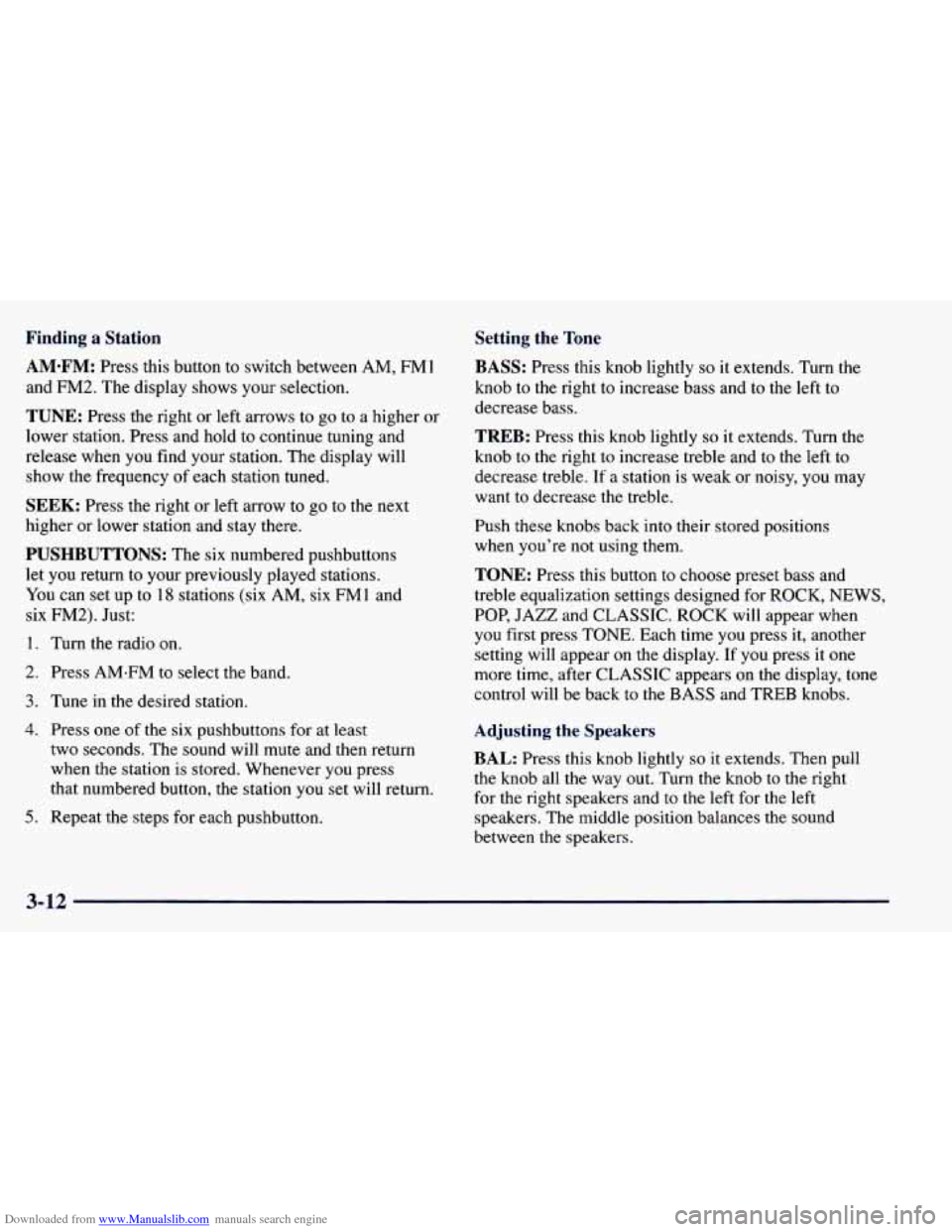
Downloaded from www.Manualslib.com manuals search engine Finding a Station
AM-FM: Press this button to switch between AM, FM1
and FM2. The display shows your selection.
Setting the Tone
BASS: Press this knob lightly so it extends. Turn the
knob to the right to increase bass and to the left to
decrease bass.
TUNE: Press the right or left arrows to go to a higher or
lower station.
Press and hold to continue tuning and
release when you find your station. The display will
show the frequency of each station tuned.
SEEK: Press the right or left arrow to go to the next
higher or lower station and stay there.
PUSHBUTTONS: The six numbered pushbuttons
let you return to your previously played stations.
You can
set up to 18 stations (six AM, six FM1 and
six FM2). Just:
1. Turn the radio on.
2. Press AM-FM to select the band.
3. Tune in the desired station.
4. Press one of the six pushbuttons for at least
two seconds. The sound will mute and then return
when the station is stored. Whenever
you press
that numbered button, the station you set will return.
5. Repeat the steps for each pushbutton.
TREB: Press this knob lightly so it extends. Turn the
knob to the right
to increase treble and to the left to
decrease treble. If a station is weak or noisy, you may
want to decrease the treble.
Push these knobs back into their stored positions
when you’re
not using them.
TONE: Press this button to choose preset bass and
treble equalization settings designed for ROCK, NEWS.
POP, JAZZ and CLASSIC. ROCK will appear when
you first press TONE. Each time you press it, another
setting will appear
on the display. If you press it one
more time, after CLASSIC appears on the display, tone
control will be back
to the BASS and TREB knobs.
Adjusting the Speakers
BAL:
Press this knob lightly so it extends. Then pull
the knob all the way out. Turn the knob
to the right
for the right speakers and to the left for the left
speakers. The middle position balances the sound
between
the speakers.
3-12
Page 147 of 364
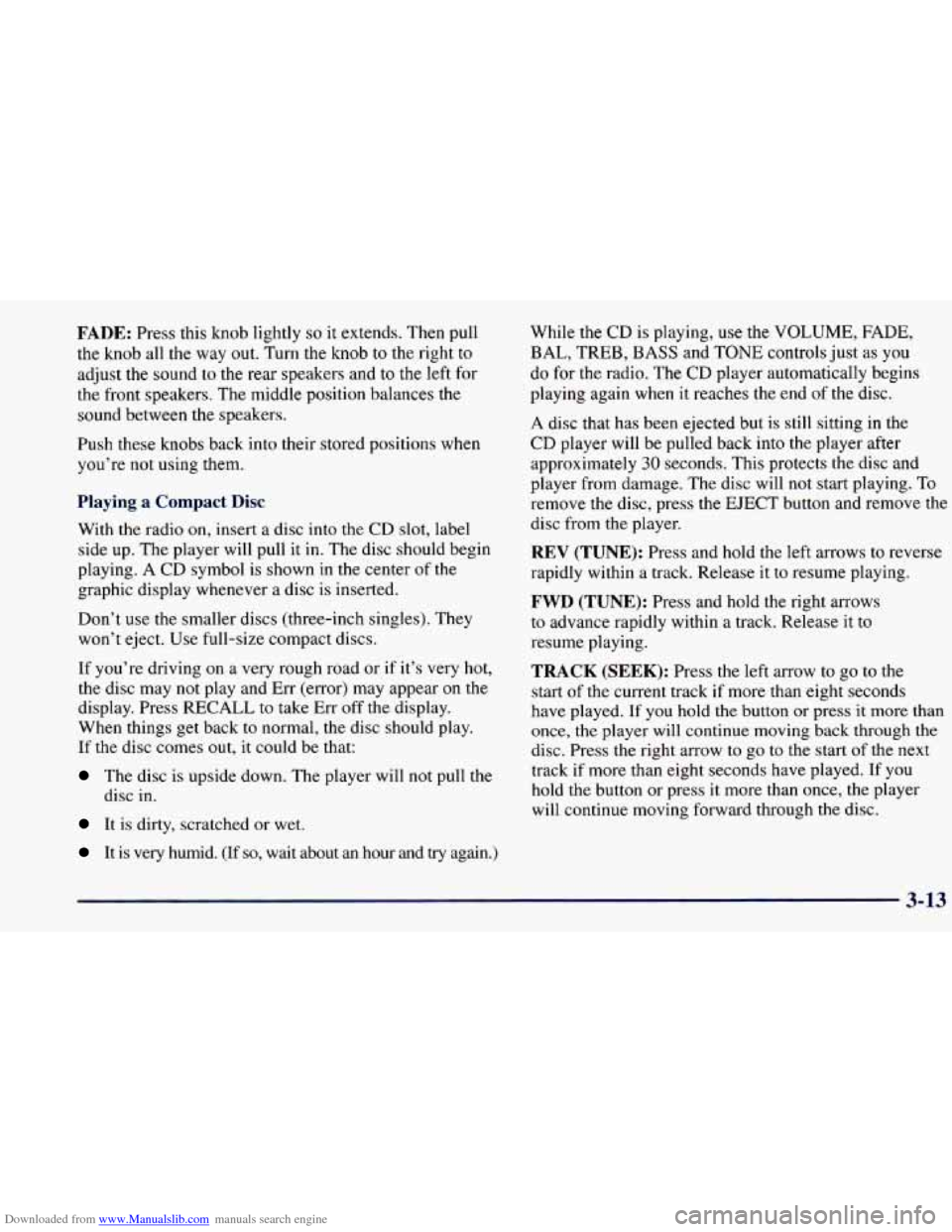
Downloaded from www.Manualslib.com manuals search engine FADE: Press this knob lightly so it extends. Then pull
the knob all the way out. Turn the knob to the right to
adjust the sound to the
rear speakers and to the left for
the front speakers. The middle position balances the
sound between the speakers.
Push these knobs back into their stored positions when
you’re not using them.
Playing a Compact Disc
With the radio on, insert a disc into the CD slot, label
side up. The player will pull it in. The disc should begin
playing.
A CD symbol is shown in the center of the
graphic display whenever a disc is inserted.
Don’t use the smaller discs (three-inch singles). They
won’t eject. Use full-size compact discs.
If you’re driving on a very rough road or if
it’s very hot,
the disc may not play and Err (error) may appear
on the
display. Press
RECALL to take Err off the display.
When things get back to normal, the disc should play.
If the disc comes out, it could be that:
The disc is upside down. The player will not pull the
disc in.
It is dirty, scratched or wet.
It is very humid. (If so, wait about an hour and try again.) While
the CD is playing, use the VOLUME, FADE,
BAL, TREB, BASS and TONE controls just as you
do for the radio. The CD player automatically begins
playing again when it reaches the end
of the disc.
A disc that has been ejected but is still sitting in the
CD player will be pulled back into the player after
approximately
30 seconds. This protects the disc and
player from damage. The disc will not start playing. To
remove the disc, press the
EJECT button and remove the
disc from the player.
REV (TUNE): Press and hold the left arrows to reverse
rapidly within
a track. Release it to resume playing.
FWD (TUNE): Press and hold the right arrows
to advance rapidly within a track. Release it to
resume playing.
TRACK (SEEK): Press the left arrow to go to the
start of the current track if more than eight seconds
have played.
If you hold the button or press it more than
once, the player will continue moving back through the
disc. Press the right arrow to go to the start of the next
track if more than eight seconds have played.
If you
hold the button or press it more than once, the player
will continue moving forward through the disc.
Page 149 of 364
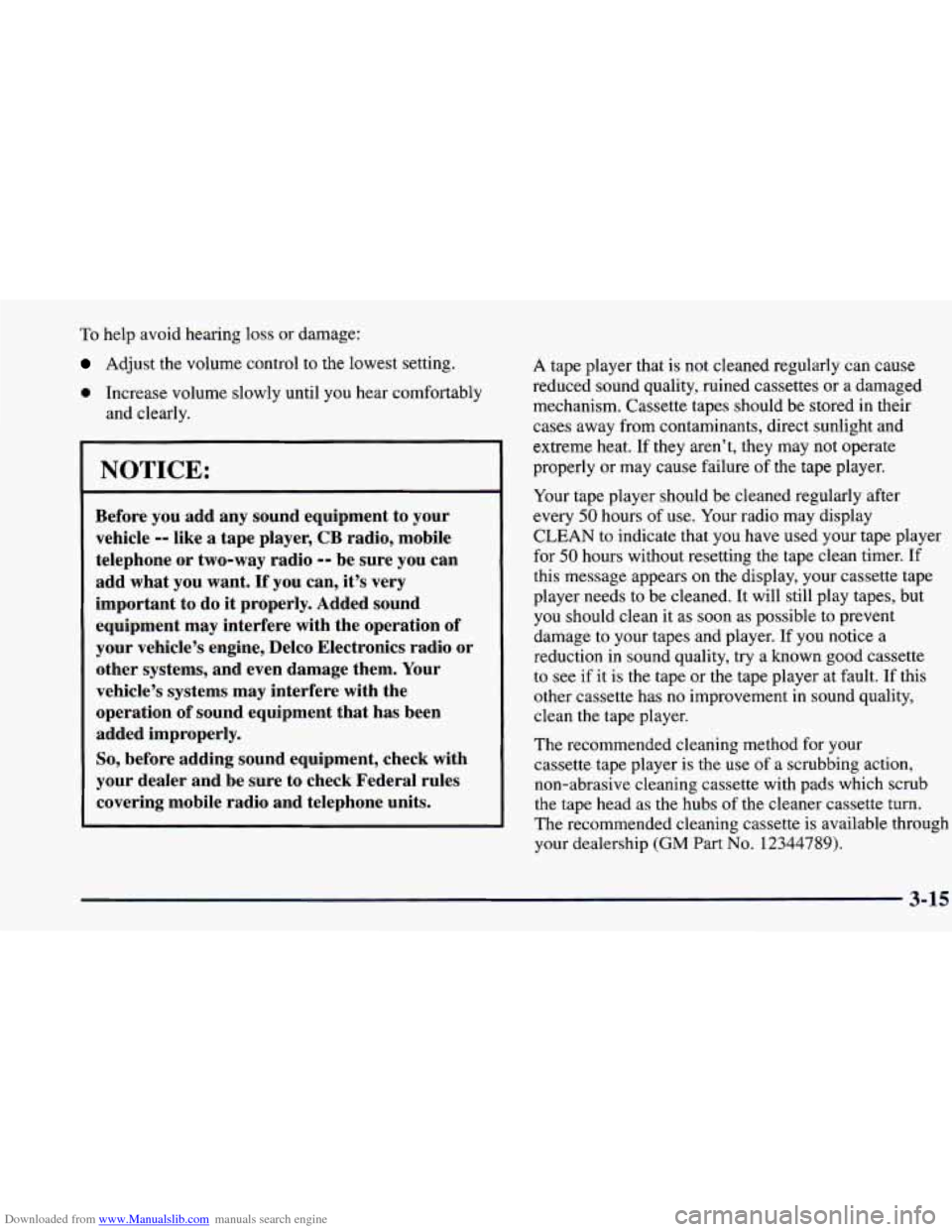
Downloaded from www.Manualslib.com manuals search engine To help avoid hearing loss or damage:
Adjust the volume control to the lowest setting.
0 Increase volume slowly until you hear comfortably
and clearly.
NOTICE:
Before you add any sound equipment to your
vehicle
-- like a tape player, CB radio, mobile
telephone or two-way radio
-- be sure you can
add what you want.
If you can, it’s very
important to do it properly. Added sound
equipment may interfere with the operation of
your vehicle’s engine, Delco Electronics radio or
other systems, and even damage them. Your
vehicle’s systems may interfere with the
operation
of sound equipment that has been
added improperly.
So, before adding sound equipment, check with
your dealer and be sure to check Federal rules
covering mobile radio and telephone units.
A tape player that is not cleaned regularly can cause
reduced sound quality, ruined cassettes or a damaged
mechanism. Cassette tapes should be stored in their
cases away from contaminants, direct sunlight and
extreme heat. If they aren’t, they may
not operate
properly or may cause failure of the tape player.
Your tape player should be cleaned regularly after
every
50 hours of use. Your radio may display
CLEAN to indicate that you have used your tape player
for
50 hours without resetting the tape clean timer. If
this message appears on the display, your cassette tape
player needs to be cleaned. It will still play tapes, but
you should clean it as soon as possible to prevent
damage to your tapes and player.
If you notice a
reduction in sound quality, try a known good cassette
to see if it is the tape or the tape player at fault.
If this
other cassette has no improvement in sound quality,
clean the tape player.
The recommended cleaning method for your
cassette tape player
is the use of a scrubbing action,
non-abrasive cleaning cassette with pads which scrub
the tape head as the hubs of the cleaner cassette turn.
The recommended cleaning cassette is available through
your dealership
(GM Part No. 12344789).
3-15
Page 151 of 364
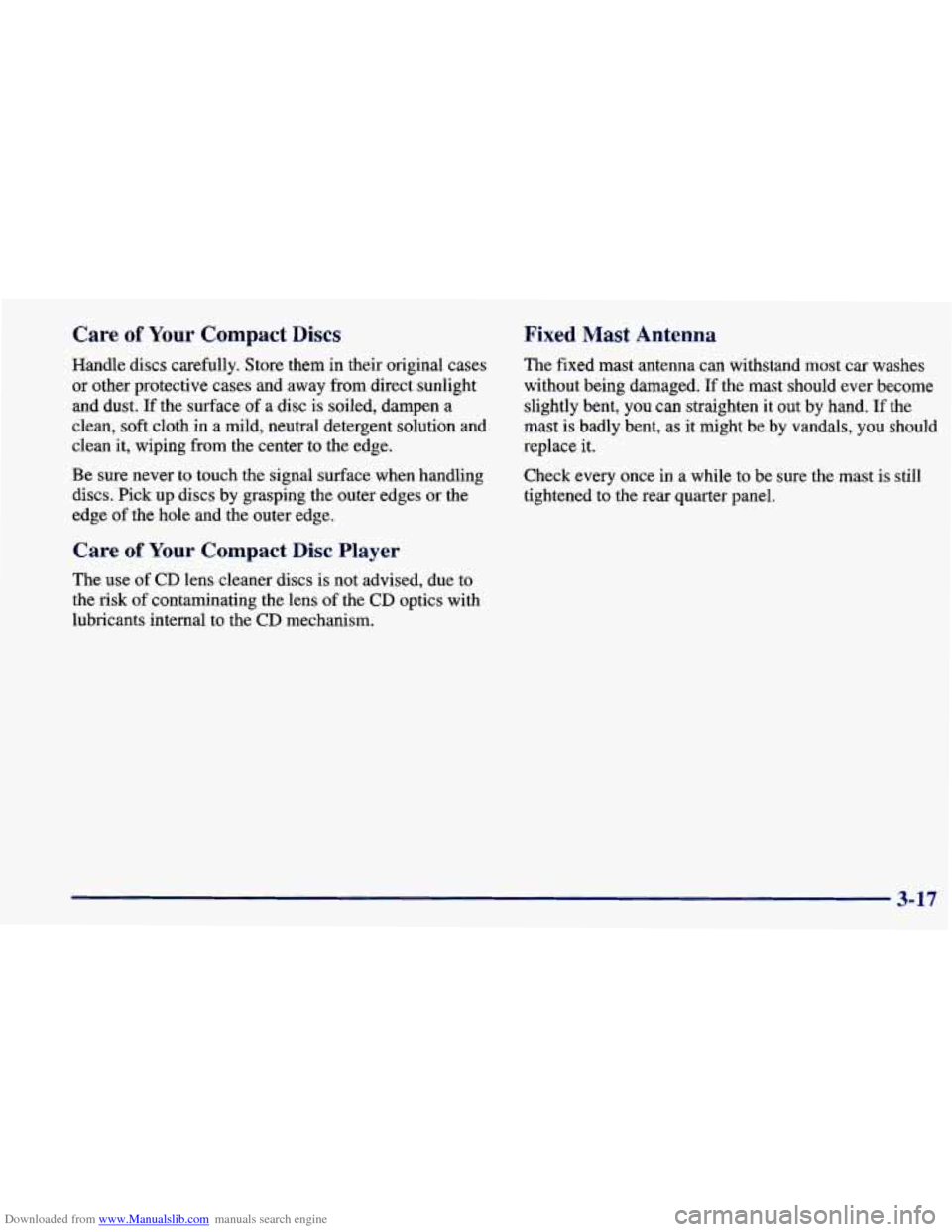
Downloaded from www.Manualslib.com manuals search engine Care of Your Compact Discs
Handle discs carefully. Store them in their original cases
or other protective cases and away from direct sunlight
and dust. If the surface of a disc is soiled, dampen a
clean, soft cloth in a mild, neutral detergent solution and
clean it, wiping from the center to
the edge.
Be sure never to touch the signal surface when handling
discs.
Pick up discs by grasping the outer edges or the
edge of the hole and the outer edge.
Care of Your Compact Disc Player
The use of CD lens cleaner discs is not advised, due to
the
risk of contaminating the lens of the CD optics with
lubricants internal to the CD mechanism.
Fixed Mast Antenna
The fixed mast antenna can withstand most car washes
without being damaged.
If the mast should ever become
slightly bent, you can straighten
it out by hand. If the
mast is badly bent, as it might be by vandals,
you should
replace it.
Check every once in a while to be sure the mast is still
tightened to the rear quarter panel.
3-17
Page 159 of 364
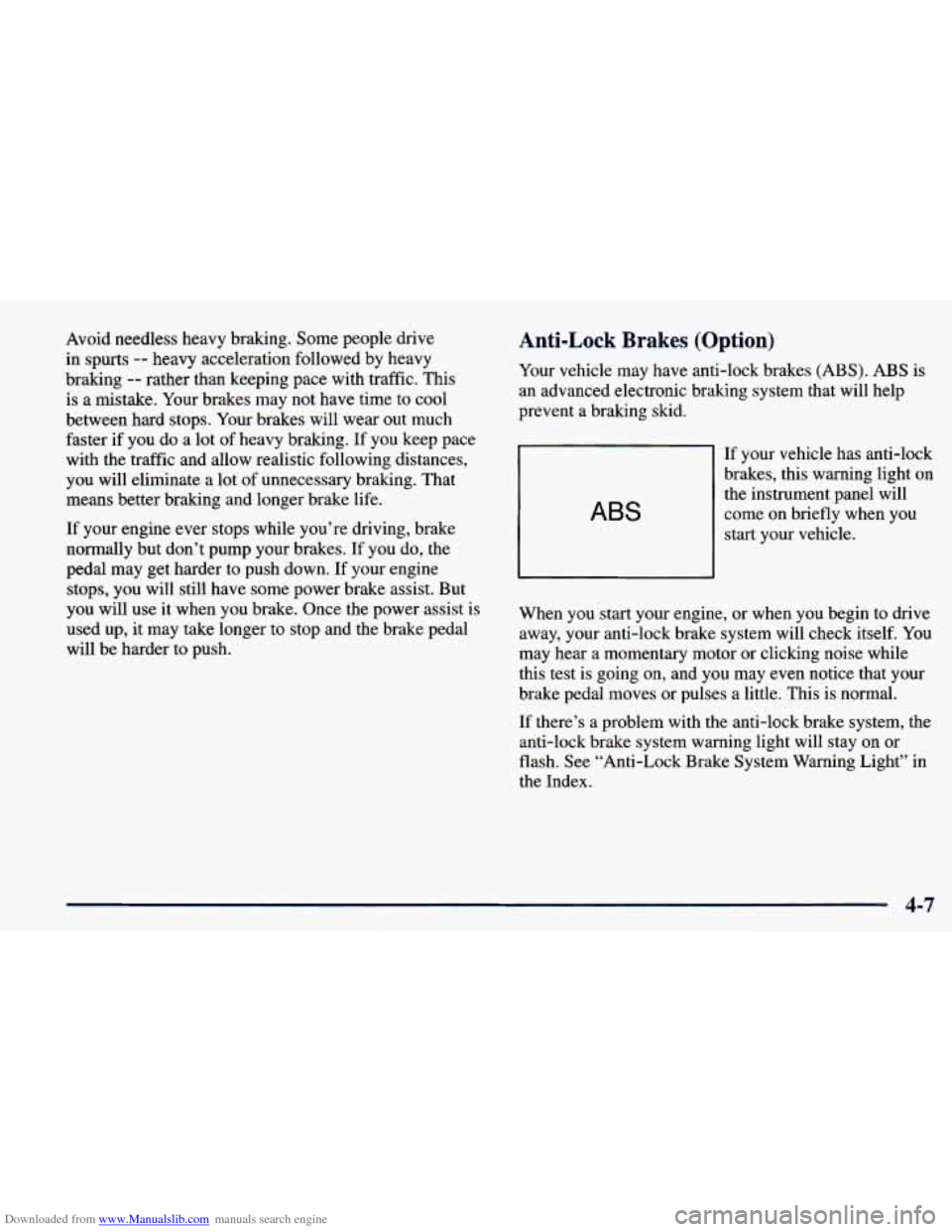
Downloaded from www.Manualslib.com manuals search engine Avoid needless heavy braking. Some people drive
in spurts
-- heavy acceleration followed by heavy
braking
-- rather than keeping pace with traffic. This
is a mistake. Your brakes may not have time to cool
between hard stops. Your brakes will
wear out much
faster if you do a lot of heavy braking. If you keep pace
with the traffic and allow realistic following distances, you will eliminate a lot of unnecessary braking. That
means better braking and longer brake life.
If your engine ever stops while you’re driving, brake
normally but don’t pump your brakes.
If you do, the
pedal may get harder to push down.
If your engine
stops, you will still have some power brake assist. But
you will use it when you brake. Once the power assist is
used up, it may take longer to stop and the brake pedal
will be harder to push.
Anti-Lock Brakes (Option)
Your vehicle may have anti-lock brakes (ABS). ABS is
an advanced electronic braking system that will help
prevent a braking slud.
ABS
If your vehicle has anti-lock
brakes, this warning light
on
the instrument panel will
come on briefly when you
start your vehicle.
When you start your engine, or when you begin to drive
away, your anti-lock brake system will check itself. You
may hear a momentary motor or clicking noise while
this test is going on, and you may even notice that your
brake pedal moves or pulses a little. This is normal.
If there’s a problem with
the anti-lock brake system, the
anti-lock brake system warning light will stay
on or
flash. See “Anti-Lock Brake System Warning Light” in
the Index.
4-7
Page 161 of 364

Downloaded from www.Manualslib.com manuals search engine Remember: Anti-lock doesn’t change the time you need
to get your foot up to the brake pedal or always decrease
stopping distance. If you get too close to the vehicle in
front of you, you won’t have time to apply your brakes
if that vehicle suddenly slows or stops. Always leave
enough room up ahead to stop, even though you have
anti-lock brakes.
Using
Anti-Lock
Don’t pump the brakes. Just hold the brake pedal down
firmly and let anti-lock work for you. You may feel a
slight brake pedal pulsation or notice some noise, but
this is normal.
Braking in Emergencies
At some time, nearly every driver gets into a situation
that requires hard braking. If
you have anti-lock, you can steer and brake at the
same time. However, if you don’t have anti-lock, your
first reaction
-- to hit the brake pedal hard and hold it
down
-- may be the wrong thing to do. Your wheels can
stop rolling. Once they do, the vehicle can’t respond to
your steering. Momentum will carry it in whatever
direction it was headed when the wheels stopped rolling.
That could be off the road, into the
very thing you were
trying to avoid, or into traffic.
If you don’t have anti-lock, use a “squeeze” braking
technique. This will give you maximum braking while
maintaining steering control. You do this by pushing on
the brake pedal with steadily increasing pressure.
In an emergency, you will probably want to squeeze
the brakes hard without locking the wheels.
If you
hear or feel the wheels sliding, ease off the brake pedal.
This will help you retain steering control.
(If you do
have anti-lock, it’s different: see “Anti-Lock Brakes”
in the Index.)
In many emergencies, steering can help you more than
even the very best braking.
4-9
Page 164 of 364
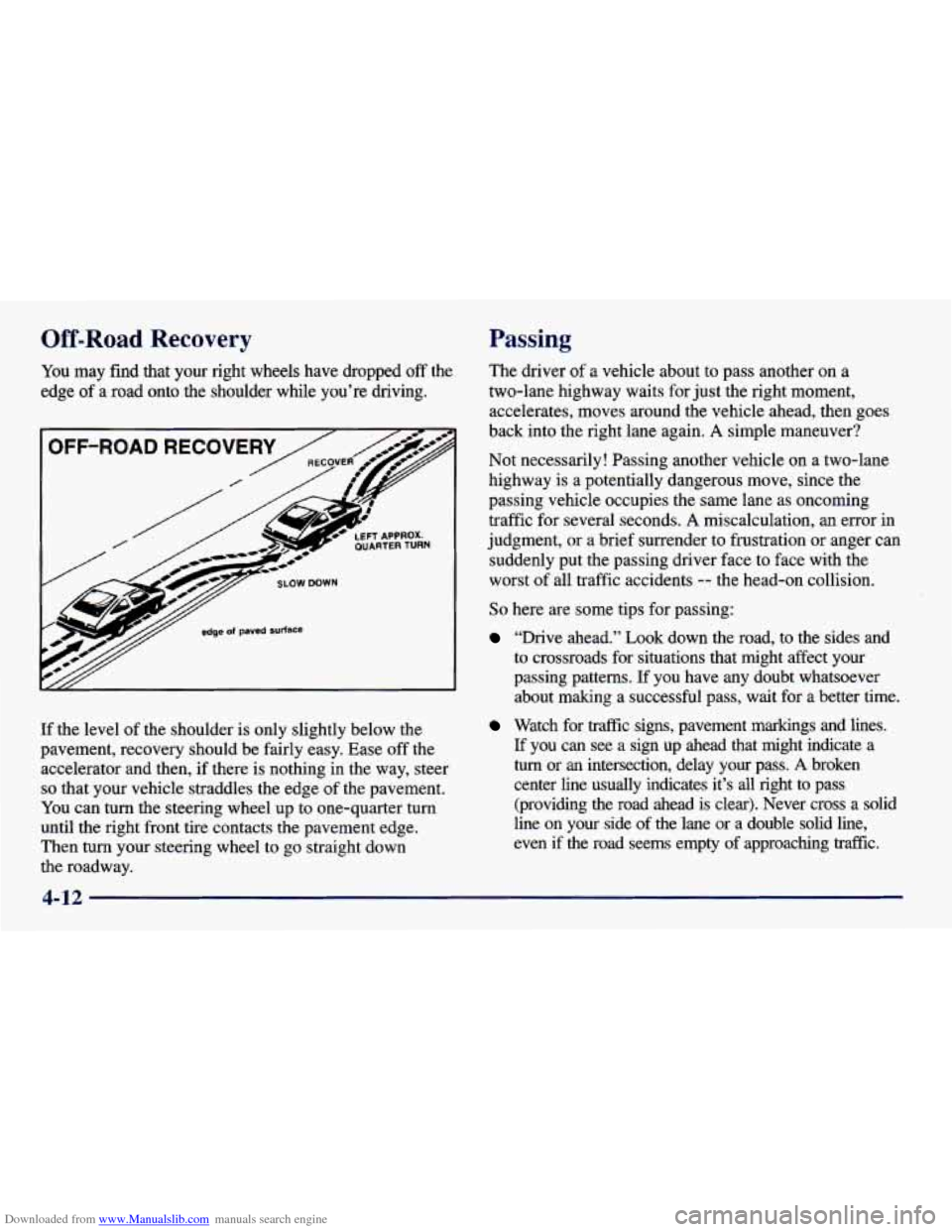
Downloaded from www.Manualslib.com manuals search engine Off-Road Recovery
You may find that your right wheels have dropped off the
edge
of a road onto the shoulder while you’re driving.
edge of paved surface
If the level of the shoulder is only slightly below the
pavement, recovery should be fairly easy. Ease off the
accelerator and
then, if there is nothing in the way, steer
so that your vehicle straddles the edge of the pavement.
You can turn the steering wheel up to one-quarter turn
until the right front tire contacts
the pavement edge.
Then turn your steering wheel to go straight down
the roadway.
Passing
The driver of a vehicle about to pass another on a
two-lane highway waits for just the right moment,
accelerates, moves around the vehicle ahead, then goes
back into the right lane again.
A simple maneuver?
Not necessarily! Passing another vehicle on a two-lane
highway is
a potentially dangerous move, since the
passing vehicle occupies the same lane as oncoming
traffic for several seconds.
A miscalculation, an error in
judgment, or
a brief surrender to frustration or anger can
suddenly put the passing driver face to face with the
worst of all traffic accidents
-- the head-on collision.
So here are some tips for passing:
“Drive ahead.” Look down the road, to the sides and
to crossroads for situations that might affect your
passing patterns.
If you have any doubt whatsoever
about making a successful pass, wait for a better time.
Watch for traffic signs, pavement markings and lines.
If you can see a sign up ahead that might indicate a
turn or an intersection, delay your pass. A broken
center line usually indicates it’s all right to pass (providing the road ahead is clear). Never cross a solid
line on your side of the lane
or a double solid line,
even if
the road seems empty of approaching traffic.
4-12
Page 167 of 364
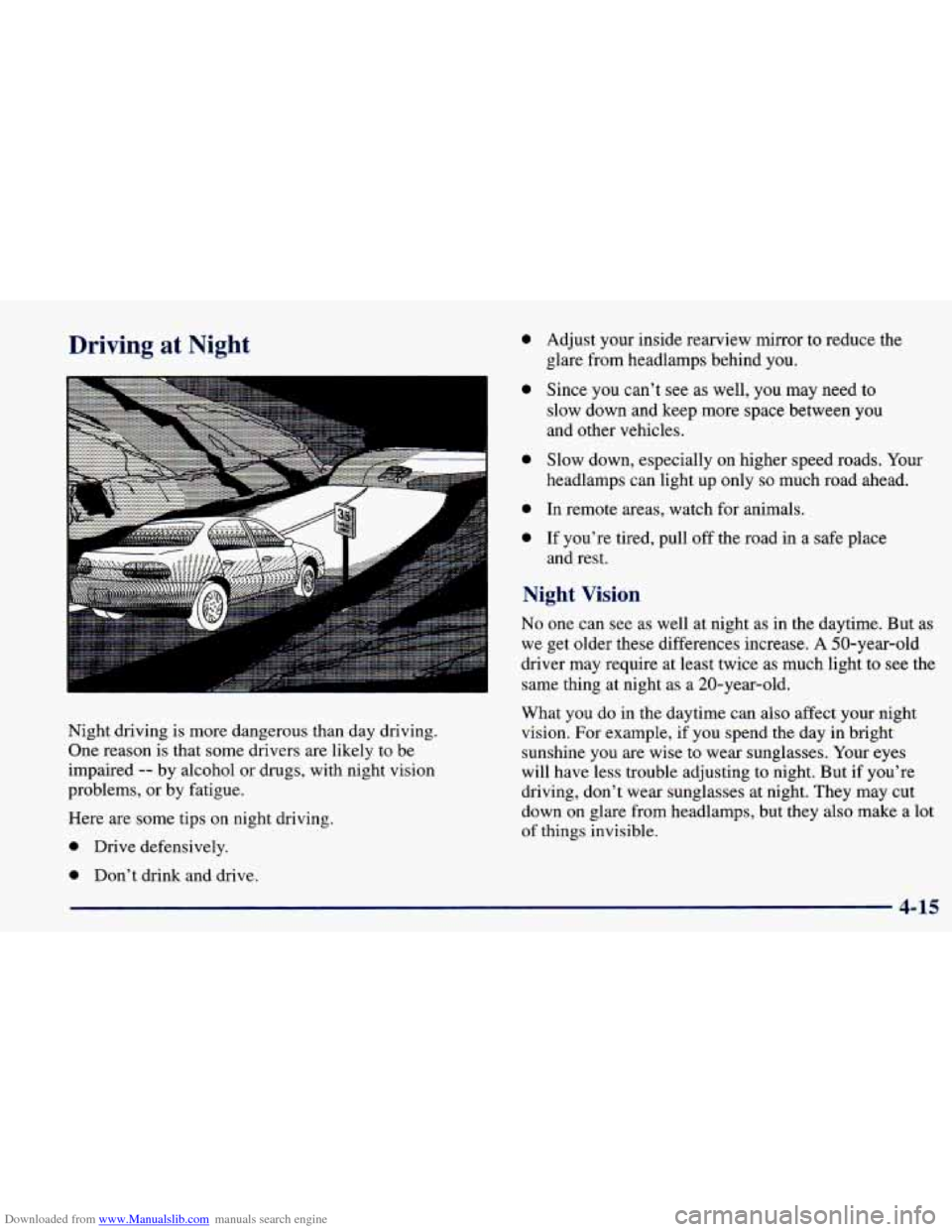
Downloaded from www.Manualslib.com manuals search engine Driving at Night
5--
. . . . . . . . . . .. . . .
Night driving is more dangerous than day driving.
One reason is that some drivers are likely to be
impaired
-- by alcohol or drugs, with night vision
problems, or by fatigue.
Here are some tips on night driving.
0 Drive defensively.
0 Don’t drink and drive.
0
0
0
0
0
Adjust your inside rearview mirror to reduce the
glare from headlamps behind you.
Since you can’t
see as well, you may need to
slow down and keep more space between you
and other vehicles.
Slow down, especially
on higher speed roads. Your
headlamps can light up only
so much road ahead.
In remote areas, watch for animals.
If you’re tired, pull
off the road in a safe place
and rest.
Night Vision
No one can see as well at night as in the daytime. But as
we get older these differences increase. A 50-year-old
driver may require at least twice as much light to
see the
same thing at night as
a 20-year-old.
What you do in the daytime can also affect your night
vision. For example, if
you spend the day in bright
sunshine you are wise to wear sunglasses. Your eyes
will have less trouble adjusting to night. But if you’re
driving, don’t wear sunglasses at night. They may cut
down on glare from headlamps, but they also make a lot
of things invisible.
4-15